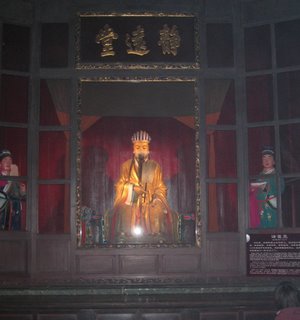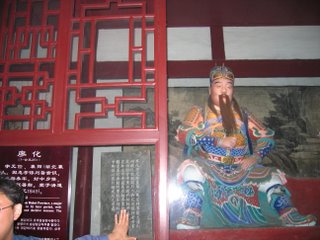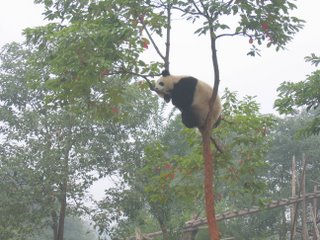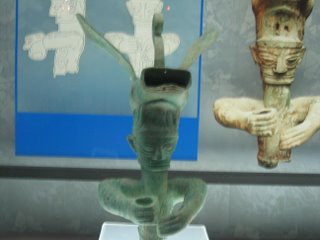18. Generals and Poets
Our Chengdu tour started with the archaeological sites I mentioned before, then a 'hot' lunch (in the Sichuan sense), and in the afternoon, we visited two shrines, one dedicated to a well-known ancient general and the other to a famous Tang dynasty poet.

The first is a shrine to Wuhou, 武侯祠 (http://www.wuhouci.net.cn/). Wuhou is more popularly known as Zhugeliang 诸葛亮, a prime minister of the kingdom of Shu during the Three Kingdoms period. This temple is built about 200 years after Christ, so we are talking about the time of the Roman empire. Walking through it does give me a feeling of history.
If you are wondering why there is a shrine just for Zhugeliang? I believe it is because Zhugeliang has always been considered one of the geniuses in Chinese history. He was not only smart, resourceful, with wide knowledge of both the literature and military strategies, but also he was known for his dedication. He served the king faithfully till his death just because the king took pains to recruit him. The photo shows his image in the shrine.

In the shrine, there are a series of figures of all the well-known generals that I had read about in my youth. But I'll show you a not-so-well-known one: General Liaohua. There is a Chinese saying that is often quoted: 蜀中无大将,廖化当先锋. (Roughly translated: there are no great generals in Shu so we ended up having to have Liaohua be the leader.) This saying is used in modern day to describe how companies that are so short of talent that they'll draft any one to be a leader. Alas, whether Liaohua was a great general or not of course is debatable and our tour guide, you can see his hand there, insisted that he was unfairly treated by history. C'est la vie!

杜甫草堂 (Dufu's Grass Hut)
Tang dynasty is well-known for its great poets and the 300 Tang Poems, a collection of poems from the period is often found in many Chinese family libraries. Dufu is a prolific and well-regarded poet who happened to live in Sichuan and so they have dedicated this shrine to him. What's interesting is that this place is called simply Dufu's Grass Hut - but it has very nice ponds and rows of bamboos. Ah, the serenity of the place, especially since it was raining when we visited, soothed me.

The first is a shrine to Wuhou, 武侯祠 (http://www.wuhouci.net.cn/). Wuhou is more popularly known as Zhugeliang 诸葛亮, a prime minister of the kingdom of Shu during the Three Kingdoms period. This temple is built about 200 years after Christ, so we are talking about the time of the Roman empire. Walking through it does give me a feeling of history.
If you are wondering why there is a shrine just for Zhugeliang? I believe it is because Zhugeliang has always been considered one of the geniuses in Chinese history. He was not only smart, resourceful, with wide knowledge of both the literature and military strategies, but also he was known for his dedication. He served the king faithfully till his death just because the king took pains to recruit him. The photo shows his image in the shrine.

In the shrine, there are a series of figures of all the well-known generals that I had read about in my youth. But I'll show you a not-so-well-known one: General Liaohua. There is a Chinese saying that is often quoted: 蜀中无大将,廖化当先锋. (Roughly translated: there are no great generals in Shu so we ended up having to have Liaohua be the leader.) This saying is used in modern day to describe how companies that are so short of talent that they'll draft any one to be a leader. Alas, whether Liaohua was a great general or not of course is debatable and our tour guide, you can see his hand there, insisted that he was unfairly treated by history. C'est la vie!

杜甫草堂 (Dufu's Grass Hut)
Tang dynasty is well-known for its great poets and the 300 Tang Poems, a collection of poems from the period is often found in many Chinese family libraries. Dufu is a prolific and well-regarded poet who happened to live in Sichuan and so they have dedicated this shrine to him. What's interesting is that this place is called simply Dufu's Grass Hut - but it has very nice ponds and rows of bamboos. Ah, the serenity of the place, especially since it was raining when we visited, soothed me.







